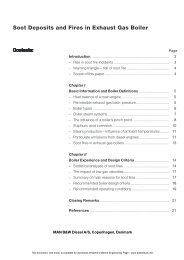The FlowFields / CurrentCollectorse -AnodecurrentcollectorPhotographs of stainless steelflow fields/current collectorsMicrograph of a milled carbon-fibercomposite flow-field. Height, widthand spacing of channels = 0.8mm(0.032 inch)Hydrogenflow fieldAir (oxygen)flow fieldWater and airCathodecurrentcollectore -Pressed against the outer surface of each backinglayer is a piece of hardware, called a plate, whichoften serves the dual role of flow field and currentcollector. In a single fuel cell, these two plates are thelast of the components making up the cell. The platesare made of a light-weight, strong, gas-impermeable,electron-conducting material; graphite or metals arecommonly used although composite plates are nowbeing developed.The first task served by each plate is to provide a gas“flow field.” The side of the plate next to the backinglayer contains channels machined into the plate. Thechannels are used to carry the reactant gas from thepoint at which it enters the fuel cell to the point atwhich the gas exits. The pattern of the flow field in theplate as well as the width and depth of the channels havea large impact on the effectiveness of the distribution ofthe reactant gases evenly across the active area of themembrane/electrode assembly. Flow field design alsoaffects water supply to the membrane and water removalfrom the cathode.The second purpose served by each plate is that ofcurrent collector. Electrons produced by the oxidationof hydrogen must be conducted through the anode,through the backing layer and through the plate beforethey can exit the cell, travel through an external circuitand re-enter the cell at the cathode plate.With the addition of the flow fields and current collectors,the polymer electrolyte membrane fuel cell is nowcomplete. Only a load-containing external circuit, suchas an electric motor, is required for electric current toflow, the power having been generated by passinghydrogen and air on either side of what looks like apiece of food wrap painted black.AnodebackingHydrogenoutletMEACathodebackingA single polymer electrolyte membrane fuel cell.This document, and more, is available for download at <strong>Martin's</strong> <strong>Marine</strong> <strong>Engineering</strong> <strong>Page</strong> - www.dieselduck.net
Efficiency, <strong>Power</strong> and Energy of Polymer Electrolyte Membrane <strong>Fuel</strong> CellCell Voltage (mV)1200100080060040020000lll200 400 600 800 1000 1200 1400 1600Current Density (mA/cm 2 )Graph of voltage vs. current density of a hydrogen/airpolymer electrolyte membrane fuel cell.Energy conversion of a fuel cell can be summarized in the following equation:Chemical energy of fuel = Electric energy + Heat energyA single, ideal H 2 /air fuel cell should provide 1.16 volts at zero current (“opencircuit” conditions), 80°C and 1 atm gas pressure. A good measure of energyconversion efficiency for a fuel cell is the ratio of the actual cell voltage to the theoreticalmaximum voltage for the H 2 /air reaction. Thus a fuel cell operating at 0.7 V isgenerating about 60% of the maximum useful energy available from the fuel in theform of electric power. If the same fuel cell is operated at 0.9 V, about 77.5% of themaximum useful energy is being delivered as electricity. The remainingenergy (40% or 22.5%) will appear as heat. The characteristic performance curvefor a fuel cell represents the DC voltage delivered at the cell terminals as a function ofthe current density, total current divided by area of membrane, being drawn from thefuel cell by the load in the external circuitThe power (P), expressed in units of watts, delivered by a cell is the product of the current (I) drawn and the terminal voltage (V) at that current(P = IV). <strong>Power</strong> is also the rate at which energy (E) is made available (P = E/t) or conversely, energy, expressed in units of watt-hours, isthe power available over a time period (t) (E = Pt). As the mass and volume of a fuel cell system are so important, additional terms are alsoused. Specific power is the ratio of the power produced by a cell to the mass of the cell; power density is the ratio of the power produced by acell to the volume of the cell. High specific power and power density are important for transportation applications, to minimize the weight andvolume of the fuel cell as well as to minimize cost.Derivation of Ideal <strong>Fuel</strong> Cell VoltagePrediction of the maximum available voltage from a fuel cell process involves evaluation of energy differences between the initial state of reactantsin the process (H 2 +1/2 O 2 ) and the final state (H 2 O). Such evaluation relies on thermodynamic functions of state in a chemical process,primarily the Gibbs free energy. The maximum cell voltage ( E) for the hydrogen/air fuel cell reaction ( H 2 + 1/2 O 2 ➔ H 2 O) at a specific temperatureand pressure is calculated [ E = - G/nF], where G is the Gibbs free energy change for the reaction, n is the number of moles ofelectrons involved in the reaction per mole of H 2 , and F is Faraday’s constant, 96, 487 coulombs (joules/volt), the charge transferred per moleof electrons.At a constant pressure of 1 atmosphere, the Gibbs free energy change in the fuel cell process (per mole of H 2 ) is calculated from the reactiontemperature (T), and from changes in the reaction enthalpy ( H) and entropy ( S)G= H - T S= - 285,800 J – (298 K)(-163.2 J/K)= - 237,200 JFor the hydrogen/air fuel cell at 1 atmosphere pressure and 25˚C (298 K), the cell voltage is 1.23 V.E = - G/nF= - (-237,200 J/2 x 96,487 J/V)= 1.23 VAs temperature rises from room temperature to that of an operating fuel cell (80˚C or 353 K), the values of H and S change only slightly,but T changes by 55˚. Thus the absolute value of G decreases. For a good estimation, assuming no change in the values of H and SG = - 285,800 J/mol – (353 K)(-163.2 J/mol K)= - 228,200 J/molThus, the maximum cell voltage decreases as well (for the standard case of 1 atm), from 1.23 V at 25˚C to 1.18 V at 80˚CE = - (-228,200 J/2 x 96,487 J/V)= 1.18 VAn additional correction for air, instead of pure oxygen, and using humidified air and hydrogen, instead of dry gases, further reduces themaximum voltage obtainable from the hydrogen/air fuel cell to 1.16 V at 80˚C and 1 atmosphere pressure.13This document, and more, is available for download at <strong>Martin's</strong> <strong>Marine</strong> <strong>Engineering</strong> <strong>Page</strong> - www.dieselduck.net

















